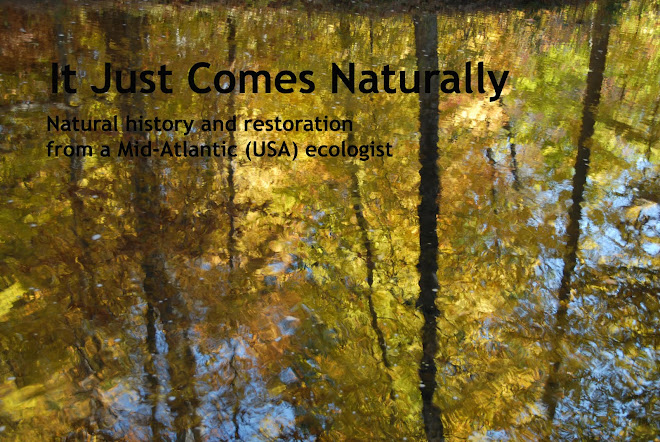The creek at 8:30 a.m. Sunday. Though it had only been about three hours
after the crest of the flooding,the creek had already subsided significantly--
a typical "flashy" urban stream.
after the crest of the flooding,the creek had already subsided significantly--
a typical "flashy" urban stream.
In our heavily urbanized watershed, restoration is always going to be a challenge. There are non-native invasive plants lurking in backyards and untended corners of commercial properties. White-tailed deer find refuge from hunters in those same pockets of green, and then make their way under cover of darkness into the preserve to eat the trees. Perhaps the biggest problem, though, is that every storm brings a new wave of flooding, and hurricanes like Irene create so much havoc on the floodplain that it's difficult to get trees firmly enough established to withstand the onslaught of the next big flood.
Floodwaters toppled trees protected in plastic shelters on the creek floodplain.
Our last hurricane was Floyd in 1999, so our trees have had 12 years to put down roots deep enough to remain in place. Unfortunately, between the highly competitive non-native porcelain-berry vines (Ampelopsis brevipedunculata) and the fact that many of the planted trees are growing in broken shade (cf., out in full sunlight), they tend to grow slowly. Few had achieved a stature to allow them to stand up to floodwaters that nearly rivaled Floyd's. So, more planting is in order over the next few years. The pattern has become discouraging and more than a little bit disheartening.
The approach to the second-oldest stone arch bridge in the county, built in 1817.
Formerly a municipal road along the creek and now closed and incorporated into the preserve trail system.
I don't think the municipality wept any tears about giving up the rights to this perennially flood-prone road.
For a time, the wetland (pond on the right of image) and the creek were one.
At normal flows, the wetland is 10 feet above the level of the creek.
After filling the wetland basin (left side, out of image), the creek washed away the split rail fence
and moved debris against this bench cemented deeply in the ground.
Bench and flood debris from a different angle. Historical note: the log jammed against the bench is hollowed out. It is a wooden water pipe used by mill workers in the mid-1800's to bring sweet water from a spring on the the hillside above the creek to one of the many water-powered mills on the banks of the creek. Even in the mid-19th century, the creek's water had become so fouled that the mill workers needed a source of clean water. The wooden pipe was excavated from the mucky bottom of the wetland when we restored the wetland pond a few years ago.
Part of a bird blind formerly located on the edge of the wetland.
Flood debris lodged against an access gate.











































